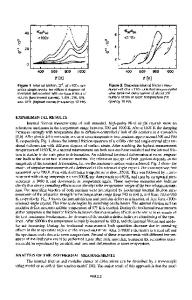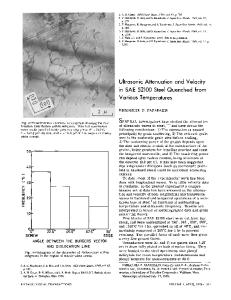TEM Observations of Dislocation Structures in Single Crystals of NiAl after High Temperature Creep
- PDF / 2,347,934 Bytes
- 6 Pages / 420.48 x 639 pts Page_size
- 39 Downloads / 291 Views
TEM OBSERVATIONS OF DISLOCATION STRUCTURES IN SINGLE CRYSTALS OF NiAl AFTER HIGH TEMPERATURE CREEP
Uwe Glatzel*, Keith R. Forbes" and William D. Nix** *Inst. Metallforschung, Technische Universitat Berlin, 1000 Berlin 12, Germany "**Dept. Mat. Sci. Eng., Stanford University, Stanford, CA 94305-2205, USA
ABSTRACT The evolution of dislocation substructures formed in single crystals of NiAl by tension creep testing at temperatures between 1123 K and 1473 K has been studied. Significant differences in the dislocation structure are evident in samples tested in different orientations. For samples tested in soft orientations, where glide of (001) dislocations is easy, some interacting (001) dislocations can be found. In hard oriented samples, the density of dislocation networks is high and low angle subgrain boundaries are observed. The subgrain size in hard oriented crystals is strongly stress dependent. In hard oriented crystals, (001) dislocations have no resolved shear stress for glide and must move by the slower process of climb; or by glide of (110) dislocations. The (001) dislocations are captured in networks, leading to a high total dislocation density in hard oriented samples compared to soft oriented crystals, whereas the dislocation density within the volume of subgrains is constant for all orientations.
INTRODUCTION The compound NiAl offers significant promise for high temperature applications, but has limited plasticity at lower temperatures. Only three independent slip systems operate at lower temperature thus limiting ductility [1]. The ductility of polycrystalline as well as single crystal NiAl increases significantly at high temperatures. The transition from brittle to ductile behavior can be explained by activating either glide of b = (110) or (111) or by climb of (001) dislocations. Evidence for (110) glide was found in [001] oriented samples tested at temperatures above 673K [2,3]. Tension creep tests carried out on single crystals with a [001] stress axis have zero resolved shear stress for (001) glide. Again, deformation must occur by either glide of (110) or climb of (001) dislocations. Samples with different orientations tested at the same temperature should result in significant differences in dislocation configurations. Anisotropic elastic calculations of line energies [4] show that dislocation configurations in samples tested at 1273 K are very close to their energetic minimum, indicating that dislocations at this temperature are free enough to take up their minimum energy configuration. Mat. Res. Soc. Symp. Proc. Vol. 288. @1993 Materials Research Society
386
EXPERIMENTAL Creep Experiments Constant stress creep tests have been carried out in the temperature range of 1123 K and 1473 K in vacuum. Single crystals of stoichiometric NiAl with stress axes parallel to [001], near [110], [223] and [11i] crystal axes have been deformed up to 20% strain. The test parameters are described in detail in [5]. The creep response in these different orientations can be grouped as follows: "* Hard oriented
Data Loading...











